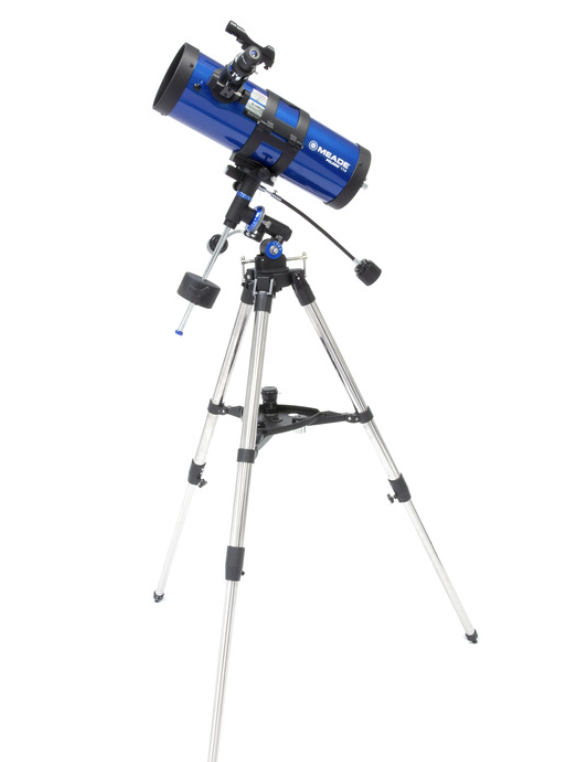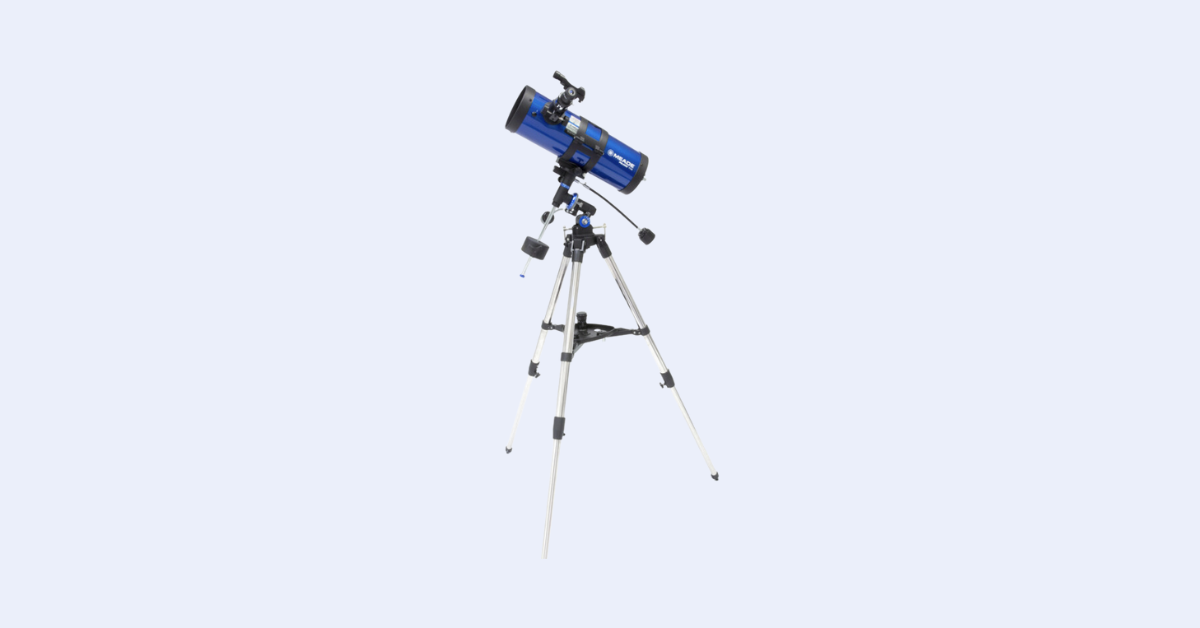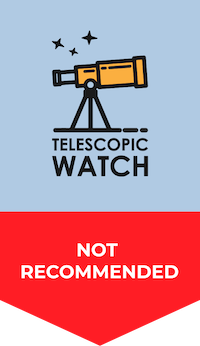The Optical Tube
The Meade Polaris 114 is purportedly a 114 mm (4.5″) f/8.8 Newtonian reflector with a focal length of 1,000 mm. This should immediately raise suspicions, as the optical tube of the telescope is evidently far too short to accommodate such a focal length.

So what’s the explanation? Like other suspiciously short scopes in its class, the Meade Polaris 114 isn’t actually a Newtonian. It’s a Bird-Jones (or Jones-Bird, depending on who you ask). It uses the same optics as the Celestron AstroMaster 114EQ, StarSense Explorer 114AZ, and many other compromised scopes of the same spec from many other brands.
In its original design, this catadioptric configuration uses a spherical primary mirror with a corrector lens just before the secondary mirror. The Bird-Jones design on paper allows for the secondary mirror to be significantly reduced in size and the primary mirror to take on an easy-to-make spherical shape, enabling a compact and stubby telescope with a long focal ratio and minimal coma. At the time the Bird-Jones was conceived, eyepieces were rudimentary and coma correctors were non-existent, so long focal ratios were necessary to achieve crisp images.
The Bird-Jones design is now outdated and no longer required. The inexpensive 3-element Meade MA eyepieces supplied with the Polaris 114 would function well enough with even a relatively fast focal ratio telescope, and indeed, similar eyepieces are supplied with beginner scopes of a variety of focal ratios. Furthermore, Meade didn’t even implement the design correctly. The Bird-Jones design used by most manufacturers today positions the corrector lens within the scope’s plastic 1.25” rack-and-pinion focuser. This leads to two issues.
First, the Polaris 114’s corrector lens cannot be easily removed, which is essentially necessary for precise collimation of the telescope and obtaining sharp images. Second, it means that the spacing between the corrector and the primary mirror is not fixed but varies depending on the eyepiece being used and other factors, such as whether the user is nearsighted or farsighted. Consequently, the correction constantly fluctuates depending on the eyepiece in use or even on who is observing through the telescope.
To collimate a typical mass-produced Bird-Jones telescope like the Polaris 114, you must dismantle the focuser using a screwdriver, cautiously unscrew a plastic retaining ring to remove the corrector, collimate as you would with a regular Newtonian, and then carefully re-insert the corrector without getting any focuser grease or fingerprints on it. This is not something you can or would want to do every time you set up the scope. You could also collimate on a star if you’re only making fine adjustments, but this takes practice. Thankfully, the primary mirror can be adjusted without any tools, which makes for a slightly less frustrating experience than using a screwdriver.
When collimated, the Polaris 114 can produce images of acceptable quality, although the sharpness decreases as you approach the edges of the field, and the glare and chromatic aberration from the corrector don’t help. You might be content with the views through this scope. However, the effort needed to achieve this and the fact that true Newtonian reflectors with wider fields of view and similar or larger apertures are available at the same price make it difficult to find a rational reason to willingly endure the Polaris 114 and its flawed optical design.
To attach to its mount, the Polaris 114 uses a pair of tube rings, allowing the tube to rotate and be slid back and forth for balance on the declination axis and comfortable positioning of the eyepiece and finder. These rings are in turn bolted to a universal Vixen-style dovetail for attachment to any astronomical telescope mount, including the provided Polaris EQ2 unit.
Accessories
The three eyepieces included with the Meade Polaris telescopes are plastic-bodied 1.25″ Meade MA 3-element eyepieces. Those provided with the Polaris 127 are a 26 mm (39x), a 9mm (111x), and a 6.3 mm (159x), all of which can be used with the 2x Barlow to double their respective magnifications to 78x, 222x, and 318x. All use glass optics, but mostly plastic components.
The 26mm and 9mm MA eyepieces are decent, but the 6.3mm provides too much magnification to be useful with the Polaris 114’s compromised optics and also has so little eye relief that it is virtually impossible to comfortably use. The provided Barlow is fairly low quality and is, of course, of no use with any eyepieces other than the 26mm MA, since it will provide too much magnification for the Polaris 114 to handle when coupled to the 9mm or 6.3mm eyepieces.
The Polaris 114 comes with a red-dot finder, which does not quite match the quality generally found in Celestron and Sky-Watcher models. Although it operates reasonably well and is an improvement over inferior 5×24 or 6×30 finders, adjusting it can be difficult, the on/off switch is tiny, and the plastic window used to view the projected red dot is slightly tinted, diminishing the brightness of the sky view. While it might be adequate and replacing it may not be financially sensible, it is far from a well-crafted device.
The Polaris EQ2 Mount
The EQ2 equatorial mount supplied with the Meade Polaris telescopes is a standard, inexpensive German equatorial design, featuring tiny, impractical setting circles that serve as mere decoration. There is no provision for the installation of any sort of polar scope – thankfully, the mount at least has a Vixen dovetail saddle, allowing it to accept other optical tubes interchangeably without requiring tools. Although the Polaris EQ2 mount is flimsily constructed, slightly complex to use, and not the most stable, it is sufficient for the Polaris 114, though weighing it down with something – either by filling the legs or suspending a heavy item on the accessory tray – will help to reduce vibrations.
Once polar alignment and balancing are accomplished, you direct the Polaris EQ2 across the sky by loosening the clutches and locking them when you are near your desired object. The EQ2 mount comes with flexible slow-motion cables for both axes and fine adjustments in altitude, as well as azimuth for precise polar alignment. German equatorial mounts can often position the eyepiece of a Newtonian awkwardly, requiring you to rotate the tube in its rings to reposition it more comfortably.
You can incorporate a single-axis motor drive, such as Celestron’s “Logic Drive,” to eliminate manual tracking entirely from the Polaris 114, although the mount, telescope, and drive are not appropriate for long-exposure astrophotography.
Should I buy a Used Meade Polaris 114?
Given the low-quality optics and accessories of the Meade Polaris 114, I feel that a used unit is not worth much, and the usual caveats of checking for damage to the mirror coatings, tripod, and accessories of course apply. If you can get one for a very low price and understand its limitations, a used Polaris 114 might be worthwhile; otherwise, don’t bother.
Alternative Recommendations
The Meade Polaris 114 is not a scope we’d recommend – check out some of these alternatives instead:
Under $250
- The Orion StarBlast 4.5 Astro/Zhumell Z114 offers the same aperture as the Polaris 114, but with a wider field of view at half the focal length and truly parabolic primary mirrors capable of delivering impressive performance and hassle-free collimation. These two telescopes, in the same order, are our top picks in this price range for the same reasons.
- The Zhumell Z100/Orion SkyScanner 100mm features good quality included accessories, an extremely compact form factor, sharp parabolic optics, and an easy-to-use tabletop Dobsonian mount, though it’s not quite as powerful as 114mm and larger reflectors. Like the StarBlast and Z114, the Z100/SkyScanner are essentially identical to each other.
- The Orion StarBlast II 4.5 EQ offers a similar mount to the Polaris 114, but has quality parabolic optics and a better provided accessory package – along with an often lower price, too.
$250-$350
- The Sky-Watcher Heritage 130P provides more aperture than the Polaris 114 with a truly parabolic primary mirror, quality included eyepieces, and a much wider possible field of view due to its shorter focal length. The scope collapses to fit into a backpack and is easy to set up, aim, and use.
- The Sky-Watcher Heritage 150P features a large 150mm (6”) primary mirror for far better performance than 114mm and 130mm scopes can possibly offer, and the same collapsible tube, Dobsonian mount, and high-quality accessories as the smaller Heritage 130P. A computerized version, the Virtuoso GTi 150P, is also available and is similarly one of our top picks for its price.
- The Celestron Omni XLT 102AZ features sharp refractor optics (though riddled with some chromatic aberration) and a simple alt-azimuth mount, with performance on par with good 114mm reflectors on most targets. The upgraded Celestron StarSense Explorer DX 102AZ adds another eyepiece and Celestron’s StarSense Explorer technology to the mix.
Aftermarket Accessory Recommendations
The Meade Polaris 114 already comes with an adequate set of included eyepieces; a 15mm redline or goldline (67x) could be of some utility but may or may not be worth purchasing. A Celestron Logic Drive will allow the Polaris EQ-2 mount to automatically track the sky, freeing you from having to make constant adjustments by hand on the right ascension axis.
Additionally, a UHC nebula filter, while certainly expensive to purchase for the Polaris 114, can enhance your views of bright nebulae such as Orion (M42), the Swan (M17), or the Lagoon (M8) by screwing onto a low-power eyepiece like the provided 26mm MA. It isn’t a cure-all for light pollution and only works on nebulae, but a UHC is an excellent item to have in your toolkit. It will also work with other, better telescopes you purchase in the future.
What can you see?
The Meade Polaris 114 is limited in high-resolution performance by its optics, which prevent you from resolving tight double stars or fine lunar and planetary detail, but it can put up acceptable views of deep-sky objects if you can contend with its rather constrained field of view compared to other options of this aperture, which usually have a shorter focal length. Light pollution is the primary limiting factor you’ll face in observing deep-sky objects with any telescope of sufficient aperture anyway, though the poor quality optics of the Polaris 114 are likely to eliminate any hope of resolving globular star clusters, which appear as featureless fuzzy orbs in this telescope but are usually resolved with a good quality 114mm reflector. Open star clusters look spectacular from almost any location due to their brightness, and the Polaris 114 will display hundreds of colorful stars in bright ones like M35, M45 (the Pleiades), M11, or the Double Cluster.
Galaxies can also be observed with the Polaris 114, but most are too faint to resolve details; however, galaxies with prominent dust lanes like M82, M31, M64, and M104 might reveal them under dark or semi-dark skies with some patience. Bright emission nebulae like the Orion Nebula (M42) or the Lagoon Nebula (M8) exhibit star clusters within wispy details that are best seen under dark skies or with a UHC narrowband nebula filter.
If you manage to collimate it somewhat acceptably, the Polaris 114 can provide reasonably pleasant views of the Moon. Venus’ phases can be observed, while Mercury’s might be slightly more challenging. A dark spot or two on Mars’ surface, along with one of the planet’s polar ice caps, are possible to see when the planet is near Earth. Jupiter’s moons and cloud belts are easy to resolve, of course, while the polar zones and Great Red Spot will likely be elusive. The moons should appear as disks at this aperture, but the Polaris 114’s shoddy optics may blur them too much to see during transits, though their shadows may still show up. Saturn’s rings and a few moons can be detected. Uranus and Neptune appear as fuzzy, star-like dots, assuming you manage to locate them at all initially.
Astrophotography
The optics in the Meade Polaris 114 are of such poor quality that taking decent pictures with it becomes an unattainable goal. Even if this weren’t the case, a camera, whether directly attached or piggybacked, would disrupt the balance and strain the EQ2 mount excessively. As a result, attempting even a piggybacked shot would lead to frustration, and long exposure astrophotography should be dismissed. For planetary and lunar photography, where one records video and stacks it with a program like Registax or AutoStakkert, your biggest obstacle apart from the substandard optics of the Polaris 114, which ruin its usefulness for the task anyway, would be the scope’s lightweight mount bouncing and wobbling as you turn the right ascension knob to track the sky, probably placing your target outside the camera’s narrow field of view.



